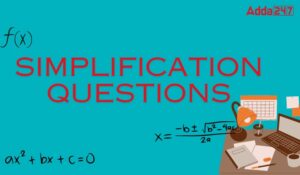Quantity comparison questions are a common type of question in bank exams that test your ability to quickly analyze and compare numerical values. These questions typically present two quantities, A and B, and require you to determine whether Quantity A is greater than, less than, or equal to Quantity B. To solve these questions efficiently, it is essential to develop strong mental math skills and the ability to identify patterns and shortcuts. Practice is key to mastering quantity comparison questions and improving your overall performance in bank exams.
Quantity Comparison Questions for Bank Exams
Quantity comparison questions often involve simple arithmetic operations, such as addition, subtraction, multiplication, and division. However, the challenge lies in applying these operations correctly and efficiently under time constraints. It is important to avoid making careless errors and to use estimation techniques to quickly narrow down the possibilities.
Directions: In each of the following questions, read the given statement and compare
Quantity I and Quantity II on its basis. (Only quantity is to be considered)
1. Quantity I: Speed of boat in still water, if a man can travel 54 km downstream in 9 hours and 40 km upstream in 10 hours.
Quantity II: Speed of boat in still water, if a man can travel 45 km downstream in 9 hours and the speed of the stream is 1 kmph.
A. Quantity I ≤ Quantity II
B. Quantity I ≥ Quantity II
C. Quantity I > Quantity II
D. Quantity I < Quantity II
E. Quantity I = Quantity II
2. Quantity I: Age of mother, if the age of Smiti is 1/7th of her mother’s age and after 5 years Smiti’s age will be 12 years.
Quantity II: Age of mother, if the ratio of the ages of Sukriti and her mother is 3: 7 and after 3 years the ratio of their ages will be 6: 13.
A. Quantity I ≤ Quantity II
B. Quantity I ≥ Quantity II
C. Quantity I > Quantity II
D. Quantity I < Quantity II
E. Quantity I = Quantity II
3. Quantity I: A bag contains 3 green, 2 yellow, and 3 purple balls. Two balls are drawn at random, what is the probability that no ball is purple?
Quantity II: (7x – 8) (14x – 5) = 0
A. Quantity I ≤ Quantity II
B. Quantity I > Quantity II
C. Quantity I = Quantity II
D. Quantity I < Quantity II
E. Quantity I ≥ Quantity II
4. What is the area of the rectangle?
Quantity I: The area of the rectangle is equal to the area of the square whose side is 24 cm.
Quantity II: The perimeter of the rectangle is 88cm, if the ratio of the length and the breadth of the rectangle is 6: 5.
A. Quantity I = Quantity II
B. Quantity I < Quantity II
C. Quantity I ≤ Quantity II
D. Quantity I ≥ Quantity II
E. Quantity I > Quantity II
5. Anuj can do half of the work in 12 days and Manoj can do the whole work in 30 days.
Quantity I: In how many days will Anuj and Manoj do the whole work?
Quantity II: If Anuj starts the work and works for 4 days, after Manoj joins him, in how many days will the whole work be completed?
A. Quantity I ≤ Quantity II
B. Quantity I ≥ Quantity II
C. Quantity I > Quantity II
D. Quantity I < Quantity II
E. Quantity I = Quantity II
6. Quantity I: Selling price, if the cost price is Rs. 50,000 and the profit is 20%.
Quantity II: Selling price, if the cost price is Rs. 50,000 and the shopkeeper gained 50/3 %
after giving a discount of 25%
A. Quantity: I > Quantity: II
B. Quantity: I ≥ Quantity: II
C. Quantity: II > Quantity: I
D. Quantity: II ≥ Quantity: I
E. Quantity I = Quantity II or relation cannot be established
7. Quantity I: A boat goes from point P to Q downstream having a distance of 120 m and comeback to point T which is in the middle of P and Q in 6 seconds then what is the speed of the boat (Kph) if the speed of the stream is 10m/s?
Quantity II: The ages of Ajinkya and Rahane 5 years ago is in the ratio 3:2 and after 15 years the ratio of ages of Ajinkya to Rahane is 17:13, then what is the sum of the ages in years of Ajinkya and Rahane 9 years from now?
A. Quantity: I > Quantity: II
B. Quantity: I ≥ Quantity: II
C. Quantity: I < Quantity: II
D. Quantity: II ≥ Quantity: I
E. Quantity I = Quantity II or relation cannot be established
8. Quantity I: 5 years ago, the ratio of Seema and Meera’s age was 8: 5. Two years hence, the ratio of their ages will become 5: 4 Find the present age of Meera.
Quantity II: The age of the son is half the age of the mother. His sister’s age is 20 years.
The age of the mother is twice the age of his sister. Find the age of the son.
A. Quantity: I > Quantity: II
B. Quantity: I ≥ Quantity: II
C. Quantity: I < Quantity: II
D. Quantity: II ≥ Quantity: I
E. Quantity I = Quantity II or relation cannot be established
9. A box contains 7 Blue balls, 4 Green balls, 5 Grey balls, and 9 White balls.
Quantity I: If two balls are drawn at random the probability that both the balls are either Grey or Green
Quantity II: If four balls are drawn at random the probability that all are of different colors.
A. Quantity: I > Quantity: II
B. Quantity: I ≥ Quantity: II
C. Quantity: I < Quantity: II
D. Quantity: II ≥ Quantity: I
E. Quantity I = Quantity II or relation cannot be established
10. A box contains 6 pink balls, 5 blue balls, 3 green balls, and 6 yellow balls.
Quantity I: If three balls are drawn at random then the probability that all the balls are either blue or yellow.
Quantity II: If three balls are drawn at random then the probability that all are of different colors.
A. Quantity: I > Quantity: II
B. Quantity: I ≥ Quantity: II
C. Quantity: I < Quantity: II
D. Quantity: II ≥ Quantity: I
E. Quantity I = Quantity II or relation cannot be established
11. The speed of a motorboat in upstream is 75% less than that of downstream.
Quantity I: The speed of the stream is how much percentage of the speed of the motorboat in downstream?
Quantity II: The speed of the stream is how much percentage less than the speed of the motorboat in still water?
A. Quantity: I > Quantity: II
B. Quantity: I ≥ Quantity: II
C. Quantity: I < Quantity: II
D. Quantity: II ≥ Quantity: I
E. Quantity I = Quantity II or relation can’t be established
12. A shopkeeper gives 10% discount on the marked price but adds 5% tax on the discounted price.
Quantity I: If the selling price of the article is Rs. 850. 5 then what is the marked price of the article?
Quantity II: 900
A. Quantity: I > Quantity: II
B. Quantity: I ≥ Quantity: II
C. Quantity: I < Quantity: II
D. Quantity: II ≥ Quantity: I
E. Quantity I = Quantity II or relation can’t be established
13. Quantity I: ‘X’ X2 + √3X – 60 = 0
Quantity II: ‘Y’ Y2 + 7√2Y + 20 = 0
A. Quantity: I > Quantity: II
B. Quantity: I ≥ Quantity: II
C. Quantity: I < Quantity: II
D. Quantity: II ≥ Quantity: I
E. Quantity I = Quantity II or relation can’t be established
14. The ratio of A’s income to B’s income is 4: 5 and the difference between their income is Rs. 10000.
Quantity I: A saves 30% of his income then what is his expenditure?
Quantity II: B spends 45% of his income then what is his saving?
A. Quantity: I > Quantity: II
B. Quantity: I ≥ Quantity: II
C. Quantity: I < Quantity: II
D. Quantity: II ≥ Quantity: I
E. Quantity I = Quantity II or relation can’t be established
15. Two persons, P and Q together can complete a piece of work in 30 days. The efficiency of P is 20% more than that of Q.
Quantity I: If P works at 25% of his efficiency then how many days will he take to complete two-fifth of the work?
Quantity II: If Q works at 40% of his efficiency then how many days will he take to complete half of the work?
A. Quantity: I > Quantity: II
B. Quantity: I ≥ Quantity: II
C. Quantity: I < Quantity: II
D. Quantity: II ≥ Quantity: I
E. Quantity I = Quantity II or relation can’t be established
16. The time taken by a motorboat to travel 1050 km upstream is 40 hours more than the time taken by it to travel the same distance downstream. The speed of the motorboat in still water is 500% more than that of the speed of stream.
Quantity I: How much time the motorboat will take to travel the same distance in upstream?
Quantity II: How much time the motorboat will take to travel 1500 km downstream if due to wind, the speed of the stream was increased by 20%?
A. Quantity: I > Quantity: II
B. Quantity: I ≥ Quantity: II
C. Quantity: I < Quantity: II
D. Quantity: II ≥ Quantity: I
E. Quantity I = Quantity II or relation can’t be established
17. The ratio of the efficiency of a man to a woman is 4: 3. A group of 2 men and 2 women together can complete a piece of work in 12 days.
Quantity I: How many days, a group of a man and three women will take to complete the same piece of work?
Quantity II: if the efficiency of men was increased by 20% and the efficiency of a women were increased by 50% then how many days they will take to complete 75% of the piece of work if they work together?
A. Quantity: I > Quantity: II
B. Quantity: I ≥ Quantity: II
C. Quantity: I < Quantity: II
D. Quantity: II ≥ Quantity: I
E. Quantity I = Quantity II or relation can’t be established
18. When 5 liters of water were added with some quantity of pure milk then the ratio of milk to water became 3: 2.
Quantity I: In the mixture, when 1. 5 liters of pure milk are added than what will be the concentration of milk in the new mixture?
Quantity II: Instead of 5 liters of water, if 3. 5 liters of water were added and the quantity of pure milk remained the same then what would be the concentration of pure milk in the mixture?
A. Quantity: I > Quantity: II
B. Quantity: I ≥ Quantity: II
C. Quantity: I < Quantity: II
D. Quantity: II ≥ Quantity: I
E. Quantity I = Quantity II or relation can’t be established
19.A motorboat can travel x km upstream and x + 20 km downstream in 17.5 hours. If the ratio of the speed of the motorboat in still water to the speed of stream is 3: 1 and the difference between their speed is 4 km.
Quantity I: What is the value of x?
Quantity II: How much distance the motorboat will travel downstream in 5 hours 15 minutes?
A. Quantity: I > Quantity: II
B. Quantity: I ≥ Quantity: II
C. Quantity: I < Quantity: II
D. Quantity: II ≥ Quantity: I
E. Quantity I = Quantity II or relation can’t be established
20. A train of 500 meters in length can cross completely a platform of 800 meters in length in 2 minutes 10 seconds.
Quantity I: What is the speed of the train in meters per second?
Quantity II: A man running in the same direction of the train can pass the train
completely in 8 minutes 20 seconds then what was the speed of the man in
meters per sec?
A. Quantity: I > Quantity: II
B. Quantity: I ≥ Quantity: II
C. Quantity: I < Quantity: II
D. Quantity: II ≥ Quantity: I
E. Quantity I = Quantity II or relation can’t be established
Answers
1-C
2-E
3-A
4-E
5-D
6-A
7-C
8-E
9-C
10-C
11-C
12-E
13-E
14-A
15-A
16-A
17-C
18-C
19-C
20-C





 Simplification Questions For Bank Exams ...
Simplification Questions For Bank Exams ...
 Mixture & Alligation Questions for B...
Mixture & Alligation Questions for B...
 Time and Distance Questions for Bank Exa...
Time and Distance Questions for Bank Exa...





